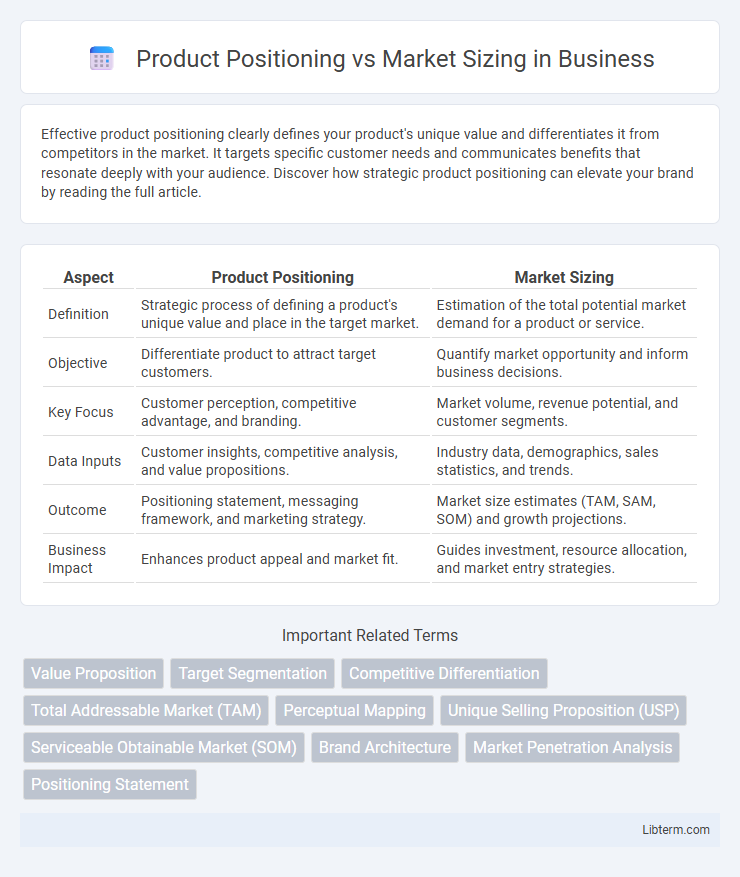Effective product positioning clearly defines your product's unique value and differentiates it from competitors in the market. It targets specific customer needs and communicates benefits that resonate deeply with your audience. Discover how strategic product positioning can elevate your brand by reading the full article.
Table of Comparison
| Aspect | Product Positioning | Market Sizing |
|---|---|---|
| Definition | Strategic process of defining a product's unique value and place in the target market. | Estimation of the total potential market demand for a product or service. |
| Objective | Differentiate product to attract target customers. | Quantify market opportunity and inform business decisions. |
| Key Focus | Customer perception, competitive advantage, and branding. | Market volume, revenue potential, and customer segments. |
| Data Inputs | Customer insights, competitive analysis, and value propositions. | Industry data, demographics, sales statistics, and trends. |
| Outcome | Positioning statement, messaging framework, and marketing strategy. | Market size estimates (TAM, SAM, SOM) and growth projections. |
| Business Impact | Enhances product appeal and market fit. | Guides investment, resource allocation, and market entry strategies. |
Introduction to Product Positioning and Market Sizing
Product positioning defines how a product is perceived in the target market relative to competitors, emphasizing unique value propositions and customer benefits. Market sizing quantifies the potential revenue or customer base within a specific market segment to assess growth opportunities and guide strategic decisions. Understanding both concepts enables businesses to align their marketing strategies with market demand and competitive dynamics effectively.
Defining Product Positioning
Defining product positioning involves identifying the unique value proposition and differentiating features that align with target customer needs and market gaps. It requires a deep understanding of competitors, customer segments, and brand strengths to create a compelling message that resonates with the intended audience. Effective product positioning sets the foundation for marketing strategies and influences product development by clarifying how the product should be perceived in the marketplace.
Understanding Market Sizing
Understanding market sizing involves estimating the total potential revenue or volume for a specific product or service within a defined market segment. Accurate market sizing requires analyzing factors such as target customer demographics, market demand, competition intensity, and economic trends to quantify the addressable market effectively. This foundational insight guides businesses in resource allocation, strategic planning, and identifying growth opportunities by clarifying the scope and scale of market potential.
Key Differences Between Product Positioning and Market Sizing
Product positioning defines how a product is perceived in the minds of target customers by emphasizing unique features and benefits relative to competitors. Market sizing quantifies the total potential demand for a product or service within a specific market, estimating revenue opportunities and customer segments. The key difference lies in product positioning driving marketing strategy and customer perception, while market sizing focuses on market opportunity assessment and business forecasting.
Importance of Product Positioning in Competitive Markets
Product positioning is crucial in competitive markets as it defines how a product is perceived relative to competitors, influencing customer preference and brand loyalty. Effective positioning highlights unique value propositions, targeting specific market segments to maximize relevance and market share. While market sizing estimates potential revenue, product positioning directly impacts a product's ability to capture and sustain demand in crowded marketplaces.
Role of Market Sizing in Business Strategy
Market sizing provides critical quantifiable data that enables businesses to estimate the potential revenue and growth opportunities within a target market, guiding resource allocation and strategic decision-making. It helps identify the total addressable market (TAM), serviceable available market (SAM), and serviceable obtainable market (SOM), which are essential metrics to evaluate market attractiveness and inform product positioning. Accurate market sizing supports risk assessment and prioritization of market segments, ensuring that product positioning aligns with viable business opportunities and maximizes return on investment.
How Product Positioning Influences Market Sizing
Product positioning shapes consumer perception and demand projections, directly impacting market sizing accuracy by defining target segments and differentiating value propositions. Effective positioning clarifies the addressable market, enabling precise estimation of market potential and competitive share. Misaligned positioning can lead to over- or underestimation of market size, affecting strategic planning and resource allocation.
Integrating Product Positioning with Market Sizing Strategies
Integrating product positioning with market sizing strategies ensures targeted messaging aligns with the identified market potential, maximizing resource allocation efficiency. Accurate market sizing informs product positioning by revealing customer segments, demand volume, and competitive dynamics, enabling precise value proposition development. This synergy drives strategic decision-making, optimizing market entry and growth opportunities by connecting product attributes with quantifiable market opportunities.
Common Mistakes in Product Positioning and Market Sizing
Common mistakes in product positioning include targeting overly broad or vague customer segments, which dilutes brand messaging and reduces market relevance. In market sizing, errors often stem from relying on inaccurate data sources or failing to differentiate between total addressable market (TAM), serviceable available market (SAM), and serviceable obtainable market (SOM). These missteps lead to unrealistic sales forecasts and misguided strategic decisions, hindering product success and market penetration.
Best Practices for Aligning Product Positioning and Market Sizing
Aligning product positioning with market sizing involves deeply understanding target customer segments and their pain points to tailor messaging that resonates and drives demand. Utilizing data-driven market sizing techniques--including TAM (Total Addressable Market), SAM (Serviceable Available Market), and SOM (Serviceable Obtainable Market)--helps prioritize positioning strategies that maximize growth potential and resource allocation. Continuous feedback loops between market insights and product messaging ensure agile adjustments, refining value propositions to capture market share effectively.
Product Positioning Infographic

 libterm.com
libterm.com